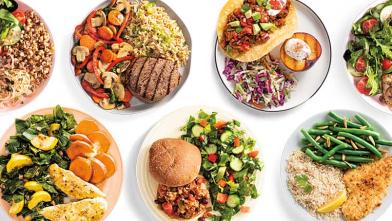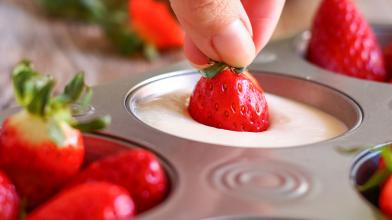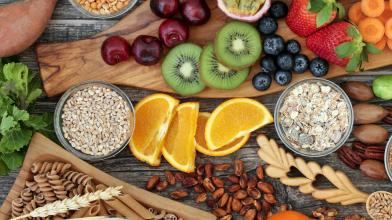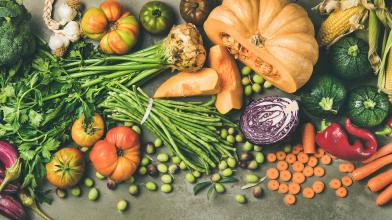One of the biggest misconceptions about living with diabetes is that you can’t have fruit. While people with diabetes of course have to monitor their glucose levels, fruits provide numerous health benefits such as:
- Providing vitamins and minerals, including potassium, vitamin C, folate, vitamin A, and vitamin E.
- Providing fiber, which helps slow digestion and contributes to lower glucose levels and improved cholesterol.
- Being naturally low in fat, sodium, and calories.
- Providing antioxidants that may protect you against certain types of cancers, free radicals, and diseases.
- A diet rich in fruit can help reduce your risk of cardiovascular disease, high blood pressure and type 2 diabetes.
Knowing this, fruits are an essential part of a healthy eating pattern. However, while most are used to eating a whole piece of fruit to reach their daily servings, fruits can make delicious, healthy desserts. Here are seven creative ways to turn fruits into dessert.
Tip: When buying fresh fruit, try to buy fruit in season, if possible. In-season fruits are more ripe, nutritious, and generally less expensive than buying them out of season.
Make Sorbet
Sorbet is simply a mixture of frozen pureed fruit sweetened with simple syrup. This dessert doesn’t need to be packed with processed sugar to satisfy your sweet tooth, though. You can make your own sugar-free simple syrup, with a 1:1 granulated alternative sweetener-to-water ratio, or use a sugar-free fruit juice. With sorbets, you can get as creative as you’d like and use any fruit you have on hand. Follow the steps listed in this easy pineapple peach sorbet recipe.
Use Bananas for Homemade Ice Cream
Did you know bananas make a great base for ice cream? Bananas are a great option to make homemade ice cream because they have less sugar than regular ice cream. Plus, banana-based ice cream is easy to make and requires few ingredients. For example, the recipes listed below have anywhere from three to five ingredients that are easy to find at your local grocery store.
Try these banana “nice” creams:
Pair Fruit with Yogurt
If you’re not a yogurt fan, adding fruit can make you become one. Yogurt, itself, is a great source of calcium, protein, and probiotics, which promote gut health. It’s also a blank slate and ready to be used for any recipe, especially dessert. We’re not just talking about parfaits, either, but also as baked dessert bars, tarts, smoothies, and mousse. Use these recipes to explore the versatility of fruit when paired with yogurt.
- Greek Yogurt Chocolate Mousse
- Fruit Salad with Honey Yogurt
- Fig and Walnut Yogurt Tarts
- Blueberry Yogurt Lemon Bars
- Pumpkin Pie Smoothie
- Apple Pie Yogurt Parfait
- Strawberry Mascarpone Parfait
- Blueberry Lemon Yogurt Parfait
DIY Fruit Popsicles
This frozen treat may be perfect for the summer, but some store-bought brands may be high in sugar and contain additives that provide little nutritional value. Fortunately, you can learn to make these at home using whole, minimally processed ingredients. Using a popsicle stick mold, you can use a similar approach to making sorbet by pureeing frozen fruit with sugar-free simple syrup or sugar-free fruit juice and pouring the fruit into the mold, and then let them freeze.
You could also take it a step further by adding other ingredients such as mint, yogurt, milk, chopped fruit, and more.
Give these a shot and try this delicious raspberry smoothie popsicle on a hot day. Need more ideas? These highly-rated popsicle recipes list different ways to experiment with textures and flavors to make these sweet treats.
No popsicle mold? No problem! You can use the fruit by itself to create your own frozen fruit pops. Try this strawberry frozen yogurt fruit pops recipe to learn how it’s done and experiment with your favorite fruits.
Try Grilled Fruit
Want to get that extra sweetness from fruit? Grill them. Grilling fruit caramelizes and intensifies its natural sugars, bringing out all of its amazing flavors. You can use any kind of fruit to throw on the grill and use it for dessert. Here are some grilled fruit recipes to try with your family:
- Grilled Peaches with Berry Compote
- Grilled Angel Food Cake with Melted Berries
- Cinnamon Maple Grilled Peaches
- Grilled Peaches with White Balsamic and Mascarpone Cream
- Cinnamon Ginger Apple on a Stick
Bake and Roast Fruit
Similar to grilling, baking amplifies the natural sweetness of fruit. Almost any fruit can be baked or roasted in an oven. Here are some ideal ones to start with:
- Apples
- Peaches
- Pears
- Bananas
- Figs
- Grapes
- Plums
- Nectarines
- Apricots
Use roasted and baked fruit as a topping on a yogurt parfait or top the baked fruit with a bit of honey and top with pecans, walnuts, or almonds. Start with these recipes:
Pies, Crisps, and Cobblers
Typically, baked fruit desserts like pies, cobblers, and crisps can be high in calories and carbohydrates from added sugars. But with a few adjustments, you can learn to enjoy these in different ways. Here are some examples:
- Easy Apple Crisp
- Cool Weather Cobbler
- Crustless Apple Pie
- Berry Crisp
- Berry Oatmeal Crisp
- Mini-Peach Crisp
Things to Remember:
- These suggestions are designed for you to think about fruit differently, beyond just having a piece of whole fruit or incorporating frozen fruit into a smoothie. Living with diabetes doesn’t mean one can’t ever satisfy their sweet tooth. Instead, it opens up brand new opportunities to find new, creative ways to do that. Fruit is naturally sweet and using the recipe ideas above, experiment with different types of fruit and learn to create your own tasty desserts.
- Deciding whether you should use fresh or frozen fruit? It depends on the recipe, however, if you’re wondering if frozen fruit is just as nutritious as fresh fruit, the answer is yes. Frozen fruits are made by picking fresh fruit at peak ripeness, freezing it, and packing it, all while allowing it to retain its nutritional value.
- While these are healthy alternatives to fruit-based desserts that are higher in calories, fat, and carbohydrate, including added sugar, portion sizes are still a key part of any healthy eating pattern. Ensure you’re using these recipes to fit your personalized diabetes and overall health goals.














